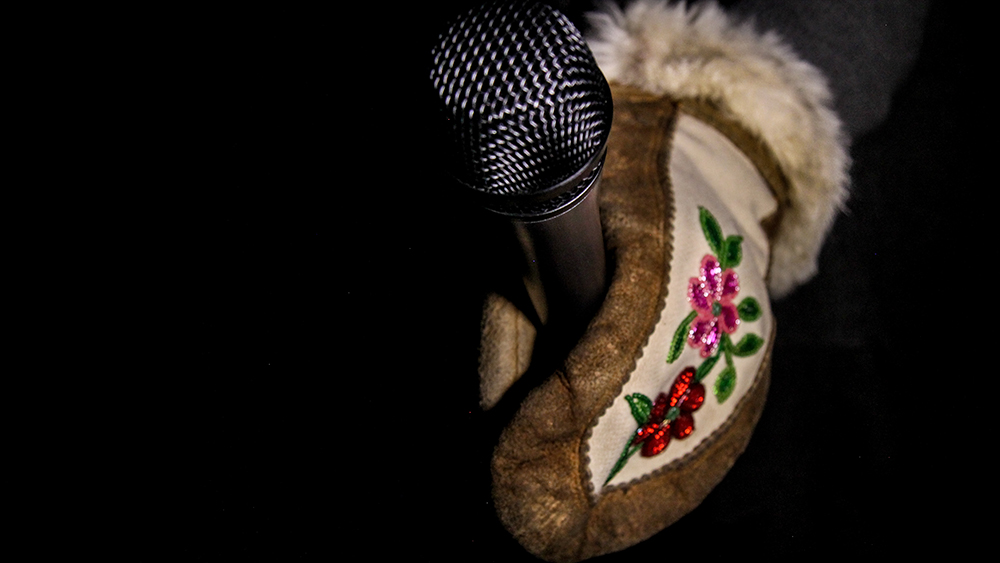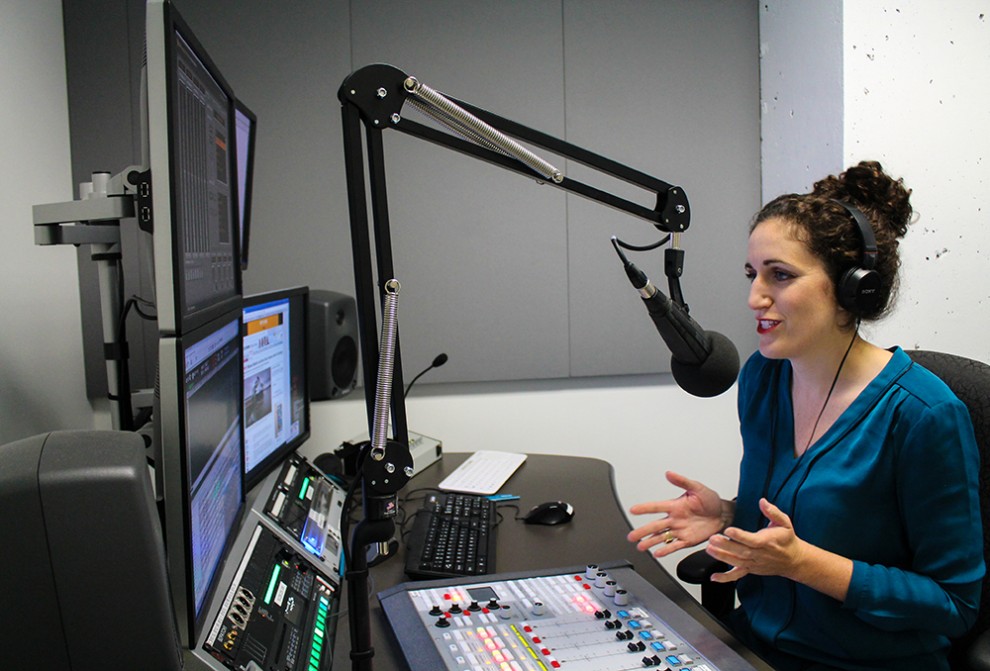The allure of the North

caption
A reporter’s most important purchase in the North: moose hide mittens.Why journalists are inspired to work in the coldest communities in Canada
When Elizabeth McMillan’s plane touched down in Yellowknife, the first thing she saw was gravel. Grey, damp, disheartening, gravel. She had travelled nine hours from Halifax on a hot, muggy day in August 2009. Her disappointment was understandable. McMillan had graduated that spring and was excited to have her first full-time job as a journalist with the Yellowknifer, a bi-weekly community newspaper. She thought she would land in a shiny new city full of promise. Instead, it was 10 degrees, overcast and Yellowknife looked like an industrial outpost. She buried herself in layers of clothing and couldn’t help but wonder how she would survive more than a month or two if it were this miserable in August.
It got worse for McMillan before it got better. By November an intense chill had settled in, and it was dark seventeen hours a day. “It’s dark when you get up, it’s dark when you get home,” says McMillan. “Your whole world shrinks a little.”
How dark is it?
Journalists working in the North face numerous challenges including high food prices, the biting cold and expensive — not to mention long — flights home to visit family and friends. Journalists also battle the difficulty of adjusting to the period of light in the summer, and darkness in the winter. During the winter solstice, Iqaluit receives three-and-a-half hours of sunlight a day. Communities further north receive less.
Shaun Malley remembers a night shortly after arriving in Iqaluit in January 2014, sitting around the kitchen table with a few new acquaintances. Amidst the chatter about their day, Malley thought: “I’m not really here”. The loneliness and isolation hit him hard at that moment, and he ached to be back in Montreal with his family and friends. Just two days into his new job with the CBC, Malley didn’t know when he would see a familiar face.
Malley woke suddenly one morning in April 2014 to the sun beating down on his face. He thought he had slept through two phone alarms and his alarm clock, and was worried he would be late for work. From the intensity of the sun Malley was certain it was nine or 10 o’clock in the morning. Rolling over in bed, squinting at his alarm clock, he realized it was only four a.m.
“That’s when I knew I needed to black up my windows,” says Malley. “For some people the darkness was too much; for me it was the constant light. It would interrupt my sleeping patterns.”
Other people, like McMillan, enjoyed the 24-hour sunlight, dreading the shorter days and longer periods of darkness that begin in October. She was surprised each year that the darkness felt isolating. “When you’re immersed in sunlight for months on end, the idea of darkness is a foreign concept. You forget what it’s like to walk home in the dark.” The crushing darkness — particularly in the morning and early evening — made her miserable during the winter. She had no energy.

caption
Elizabeth McMillan left Yellowknife in February 2015 and now works for CBC Halifax.
“Without the light-dark cycles, circadian rhythms of the body are disrupted during total darkness,” says Leon. “The normal changes in the body that trigger sleep or trigger wakefulness are disrupted.” The long periods of darkness in the North can also result in feelings of isolation. “There can be a loneliness for loved ones back home and a longing for more social interaction.”
The cold is also a challenge. Leon says everyone is affected differently because how a person reacts is related to their individual physiology. Some people may be more susceptible to frostbite and hypothermia and others may have an increased blood flow to keep the core of their bodies warm. There is a physical and mental “adaptation to the cold for everyone.”
Leon says that despite the difficulties, positive growth can come from enduring the struggles of living in the North. The extreme conditions force journalists to confront deep personal challenges. “There is a growth of self-esteem and self-confidence related to being in a difficult environment,” says Leon.
While in the North, McMillan thought about where she “wanted to be in the future.” She questioned who she was and what was important to her. “I figured out how I wanted to live my life.”
Into your soul
Many reporters decide to pursue a career in journalism because they feel they can make a difference. They want to report on stories that will shine a light on important issues, resulting in change for the people who need it most. This was the case for Patricia Bell, the senior producer with CBC in Iqaluit. She left Windsor, Ontario for the North in October 1999.
Bell is deeply affected by the number of suicides in Nunavut. “It affects me because I’ve lost people to suicide here,” she says. Her voice cracks. There have been 486 suicides since 1999 — that’s one every 10 days. Her sobs are stifled at first; the emotion is raw.
Bell lost a good friend, Nicotye Naglingniq, to suicide in 2008. Naglingniq was deeply depressed after her teenage daughter Jennifer was murdered. She worked as an administrative assistant at CBC in Iqaluit, and Bell was devastated by her death. “We still had to work (at the station) and it was very traumatic,” she says. Reporters, including Bell, are not always tough. “(Suicide) affects the fibre of who you are.”
Bell is frustrated and angry that suicides in Nunavut are not getting the attention they need. “It’s like the (national) media doesn’t give a shit,” she says. “We’re living here and we’re seeing the impact of it. But if nothing’s done, it is just going to keep continuing.”
Bell’s determination to report on suicide in Nunavut led her to interview 21-year-old Solomon Tapatia Uyarasuk, a performer with the community-based circus Artcirq. His experience with the circus gave his life meaning. He told Bell about his mother and sister attempting suicide, and how he was going to be different. “Life was his goal,” she says.
“I did that story because it was hope. Someone who had been so affected by suicide, and he had found something to direct his energy (towards),” says Bell. “I thought it would give inspiration to people out there who may be living this trauma.”
Uyarasuk died six years later in a RCMP cell in Igloolik, Nunavut. The police said he committed suicide.
“(Suicide) is something that gets into your soul,” says Bell. “It’s not a story you file away and it’s gone — there’s human loss.”
Unexpected warmth
Patrick Nagle knows some journalists will settle down but most people “will move on” after a year or two. Based in Iqaluit, Nagle is the area manager for CBC North. He handles the operations – everything from hiring journalists to making sure the plumbing gets fixed – in Nunavut and in Nunavik, Quebec. Nagle only planned to stay for six months but has been in Iqaluit for 26 years.
Reporters heading to the North are usually at the beginning of their careers. They work in Yellowknife, Iqaluit or more isolated communities like Rankin Inlet, covering a broad range of stories including politics and social issues. Nagle says they will be hit with an intensive boot camp when they arrive: working on interviewing, gaining experience in broadcast writing and honing their online skills. “I spend a lot of time working with people and coaching them as they learn their craft.”
Map: Emily Rendell-Watson
Journalists working for CBC North are paid a northern allowance each year in addition to their regular salary. The amount varies between $6,000 and $10,000 a year, and those who receive the most money live in the Eastern Arctic where the cost of living is much higher. This allowance is crucial, especially when a five-kilogram bag of all-purpose flour in Iqaluit costs $40.
There are 27 staff working for CBC North in Nunavut and two in Nunavik. Of these 21 are Inuit. Three are from southern Canada but have lived in Iqaluit for more than 15 years. Five have come from the south in the past few years.
Journalists who move back south report that their experiences up north are so profound that they stay with them after they leave. One of the first full-time reporters for the CBC Northern Service, Whit Fraser, arrived in 1967 and ran the one-man newsroom in Frobisher Bay, now Iqaluit. He covered events that shaped the modern North, including constitutional negotiations, the Mackenzie Valley Pipeline Inquiry and the assertion of Aboriginal rights though land claim negotiations. Fraser left in 1978, and the North — most importantly his connections with the people — have stayed with him throughout his journalism career.
Fraser remembers spending time with Inuit and trying to understand how their culture and history unfolded over the years. He says being “treated so well by people who may have good reason to resent you” affected him deeply. He describes “the warmth” he felt “on the inside” during these moments of human connection.
Shaun Malley was also affected by people he met in the North. He remembers standing around the filing cabinets at the CBC North office in Iqaluit, with two colleagues, dipping little pieces of fresh muktuk (whale skin and blubber) in bowls of soy sauce. One of his friends cut the muktuk with an ulu – a traditional knife. The texture, he says, is like a Starburst candy – soft, chewy and smooth in your mouth. When someone brought in “country food” they would all share it – that’s part of Inuit culture. “That’s how the culture teaches people,” says Malley. “How could I not look back at that and smile?”
An Inukshuk and a soapstone carving of a bird – given to him by friends when he left Iqaluit in July 2015 – perch on Malley’s CBC desk in Windsor, Ontario. Every day he recalls his favourite memories of the North: “Frobisher Bay, frozen solid in the middle of winter. Late summer, when the hills are covered in moss, when you can pick the blueberries off the ground.” He chokes up, thinking about it. “I don’t know if I’ll ever get to see (the North) again. It’s something that I’m going to cherish forever.”
Malley has never questioned his decision to work in Iqaluit. “It gave me a greater appreciation for what I have. Over and above making me a better storyteller, it made me a better human being,” he says. “It made me more resilient.”
Home and away
Five years after McMillan landed in Yellowknife, hopeful and expectant, she decided to leave. During a particularly difficult winter in 2014, she spent time thinking about where she wanted to be in the future. Her understanding of the North had grown immensely — and so had she. McMillan now knew she could handle anything. Most importantly, she had decided how she wanted to live her life.
Journalists go to the North expecting to gain skills and experience. While they do learn a lot about storytelling and being a journalist, they also learn a lot about themselves. Their individual experiences — battling the challenges of the North, braving the isolation and cold, and connecting with people — affected them all differently. Still, the stories they tell come back to one thing: a deeper understanding of who they are and how the North has changed them. Whether they stay up or return to southern Canada, what has made them more caring human beings has also made them better journalists.

C
Carol Amaratunga